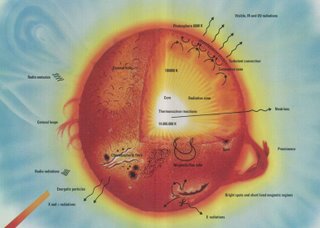The Sun that we circle year after year follows a life cycle that is the same throughout the solar system. The cycle has several stages with our Sun around 4.57 billion years old. This puts our Sun half way through its "main-sequence" evolution, during which nuclear fusion reactions in its core fuse hydrogen into helium.
Each second over 4 million tonnes of matter is converted into energy within the Suns core. The sun will spend around 10 billion years as a main sequence star.
The Sun does not yet have enough mass to explode into a supernova, instead in 4-5 billion years it will enter a red giant phase with its outer layers expanding and its core heating up. Helium fusion will begin when the core reaches around 100MK, and will produce oxygen and carbon. Entering the asymptotic giant branch of a planetary nebula phase in about 7.8 billion years, during which instabilities in interior temperature lead the surface of the sun to shed mass. While it is likely that the expansion of the outer layers of the Sun will reach the current position of Earth's orbit, recent research suggests that mass lost from the Sun earlier in its red giant phase will cause the Earth's orbit to move further out, preventing it from being engulfed. However, Earth's water will be boiled away and most of its atmosphere will escape into space. The increase in solar temperatures over this period is sufficient that by about 500-700 million years into the future, the surface of the Earth will become too hot for the survival of life as we know it.
Following the red giant phase, intense thermal pulsations will cause the Sun to throw off its outer layers, forming a planetary nebula. The only object that will remain after the outer layers are ejected is the extremely hot stellar core, which will slowly cool and fade as a white dwarf over many billions of years. This stellar evolution scenario is typical of low to medium-mass stars.
Refer to the picture above for a pictorial explanation.
Saturday, October 06, 2007
Sunday, May 27, 2007
SUN STATISTICS
Sun Statistics
Mass (kg) 1.989e+30
Mass (Earth = 1) 332,830
Equatorial radius (km) 695,000
Equatorial radius (Earth = 1) 108.97
Mean density (gm/cm^3) 1.410
Rotational period (days) 25-36*
Escape velocity (km/sec) 618.02
Luminosity (ergs/sec) 3.827e33
Magnitude (Vo) -26.8
Mean surface temperature 6,000°C
Age (billion years) 4.5
Principal chemistry
Hydrogen 92.1%
Helium 7.8%
Oxygen 0.061%
Carbon 0.030%
Nitrogen 0.0084%
Neon 0.0076%
Iron 0.0037%
Silicon 0.0031%
Magnesium 0.0024%
Sulfur 0.0015%
All others 0.0015%
Mass (kg) 1.989e+30
Mass (Earth = 1) 332,830
Equatorial radius (km) 695,000
Equatorial radius (Earth = 1) 108.97
Mean density (gm/cm^3) 1.410
Rotational period (days) 25-36*
Escape velocity (km/sec) 618.02
Luminosity (ergs/sec) 3.827e33
Magnitude (Vo) -26.8
Mean surface temperature 6,000°C
Age (billion years) 4.5
Principal chemistry
Hydrogen 92.1%
Helium 7.8%
Oxygen 0.061%
Carbon 0.030%
Nitrogen 0.0084%
Neon 0.0076%
Iron 0.0037%
Silicon 0.0031%
Magnesium 0.0024%
Sulfur 0.0015%
All others 0.0015%
Tuesday, April 24, 2007
Layers of the Sun
The chromosphere is above the photosphere. Solar energy passes through this region on its way out from the center of the Sun. Faculae and flares arise in the chromosphere. Faculae are bright luminous hydrogen clouds which form above regions where sunspots are about to form. Flares are bright filaments of hot gas emerging from sunspot regions. Sunspots are dark depressions on the photosphere with a typical temperature of 4,000°C (7,000°F).
The corona is the outer part of the Sun's atmosphere. It is in this region that prominences appears. Prominences are immense clouds of glowing gas that erupt from the upper chromosphere. The outer region of the corona stretches far into space and consists of particles traveling slowly away from the Sun. The corona can only be seen during total solar eclipses.

The corona is the outer part of the Sun's atmosphere. It is in this region that prominences appears. Prominences are immense clouds of glowing gas that erupt from the upper chromosphere. The outer region of the corona stretches far into space and consists of particles traveling slowly away from the Sun. The corona can only be seen during total solar eclipses.

Sunday, March 18, 2007
The Amazing Sun

The Sun is the most prominent feature in our solar system. It is the largest object and contains approximately 98% of the total solar system mass. One hundred and nine Earths would be able to fit across the Sun's disk, and its interior could hold over 1.3 million Earths. The Sun's outer visible layer is called the photosphere and has a temperature of 6,000°C (11,000°F). This layer has a mottled appearance due to the turbulent eruptions of energy at the surface
Subscribe to:
Comments (Atom)